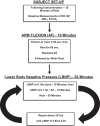Oscillatory lower body negative pressure impairs task related functional hyperemia in healthy volunteers
- PMID: 26801310
- PMCID: PMC4867344
- DOI: 10.1152/ajpheart.00747.2015
Oscillatory lower body negative pressure impairs task related functional hyperemia in healthy volunteers
Abstract
Neurovascular coupling refers to the link between an increase in neural activity in response to a task and an increase in cerebral blood flow denoted "functional hyperemia." Recent work on postural tachycardia syndrome indicated that increased oscillatory cerebral blood flow velocity (CBFv) was associated with reduced functional hyperemia. We hypothesized that a reduction in functional hyperemia could be causally produced in healthy volunteers by using oscillations in lower body negative pressure (OLBNP) to force oscillations in CBFv. CBFv was measured by transcranial Doppler ultrasound of the left middle cerebral artery. We used passive arm flexion applied during eight periodic 60-s flexion/60-s relaxation epochs to produce 120-s periodic changes in functional hyperemia (at 0.0083 Hz). We used -30 mmHg of OLBNP at 0.03, 0.05, and 0.10 Hz, the range for cerebral autoregulation, and measured spectral power of CBFv at all frequencies. Arm flexion power performed without OLBNP was compared with arm flexion power during OLBNP. OLBNP power performed in isolation was compared with power during OLBNP plus arm flexion. Cerebral flow velocity oscillations at 0.05 Hz reduced and at 0.10 Hz eliminated functional hyperemia, while 0.03 Hz did not reach significance. In contrast, arm flexion reduced OLBNP-induced oscillatory power at all frequencies. The interactions between OLBNP-driven CBFv oscillations and arm flexion-driven CBFv oscillations are reciprocal. Thus induced cerebral blood flow oscillations suppress functional hyperemia, and functional hyperemia suppresses cerebral blood flow oscillations. We conclude that oscillatory cerebral blood flow produces a causal reduction of functional hyperemia.
Keywords: functional hyperemia; lower body negative pressure; neurovascular coupling.
Copyright © 2016 the American Physiological Society.
Figures







Similar articles
-
Oscillatory lower body negative pressure impairs working memory task-related functional hyperemia in healthy volunteers.Am J Physiol Heart Circ Physiol. 2017 Apr 1;312(4):H672-H680. doi: 10.1152/ajpheart.00438.2016. Epub 2017 Feb 3. Am J Physiol Heart Circ Physiol. 2017. PMID: 28159806 Free PMC article.
-
Directional sensitivity of the cerebral pressure-flow relationship during forced oscillations induced by oscillatory lower body negative pressure.J Cereb Blood Flow Metab. 2024 Oct;44(10):1827-1839. doi: 10.1177/0271678X241247633. Epub 2024 Apr 13. J Cereb Blood Flow Metab. 2024. PMID: 38613236 Free PMC article.
-
Coupling between arterial pressure, cerebral blood velocity, and cerebral tissue oxygenation with spontaneous and forced oscillations.Physiol Meas. 2015 Apr;36(4):785-801. doi: 10.1088/0967-3334/36/4/785. Epub 2015 Mar 23. Physiol Meas. 2015. PMID: 25798890 Free PMC article.
-
Cerebral blood flow response to cardiorespiratory oscillations in healthy humans.Auton Neurosci. 2023 Mar;245:103069. doi: 10.1016/j.autneu.2022.103069. Epub 2022 Dec 23. Auton Neurosci. 2023. PMID: 36584666 Review.
-
Cerebrovascular regulation and vasoneuronal coupling.J Clin Ultrasound. 1995 Feb;23(2):125-38. doi: 10.1002/jcu.1870230207. J Clin Ultrasound. 1995. PMID: 7699100 Review.
Cited by
-
Decreasing cerebral oxygen consumption during upright tilt in vasovagal syncope.Physiol Rep. 2017 May;5(10):e13286. doi: 10.14814/phy2.13286. Physiol Rep. 2017. PMID: 28554964 Free PMC article.
-
Human cerebrovascular function in health and disease: insights from integrative approaches.J Physiol Anthropol. 2018 Feb 17;37(1):4. doi: 10.1186/s40101-018-0164-z. J Physiol Anthropol. 2018. PMID: 29454381 Free PMC article. Review.
-
Oscillatory lower body negative pressure impairs working memory task-related functional hyperemia in healthy volunteers.Am J Physiol Heart Circ Physiol. 2017 Apr 1;312(4):H672-H680. doi: 10.1152/ajpheart.00438.2016. Epub 2017 Feb 3. Am J Physiol Heart Circ Physiol. 2017. PMID: 28159806 Free PMC article.
References
-
- Bendat JS, Piersol AG. Random Data: Analysis and Measurement Procedures. New York: Wiley-Interscience, 2000, p. 437–441.
-
- Bowman CL, Ding JP, Sachs F, Sokabe M. Mechanotransducing ion channels in astrocytes. Brain Res 584: 272–286, 1992. - PubMed
-
- Cao R. The Hemo-Neural Hypothesis: Effects of Vasodilation on Astrocytes in the Mammalian Neocortex (PhD Dissertation). Boston, MA: Massachusetts Institute of Technology, 2011.
Publication types
MeSH terms
Grants and funding
LinkOut - more resources
Full Text Sources
Other Literature Sources

